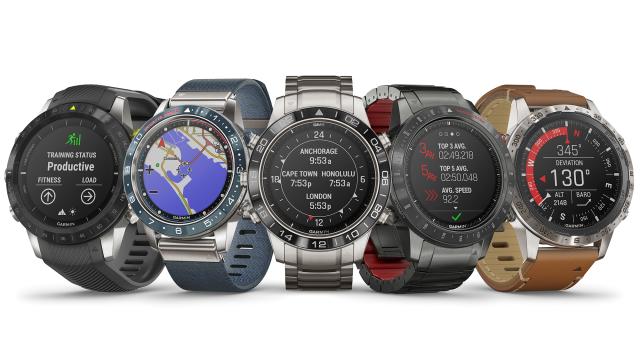Garmin has a solid track record when it comes to making smartwatches that don’t look like smartwatches. Its Vívomove HR manages to completely hide its smart capabilities under a non-descript analogue face.
Inspired by feature-packed watches from company’s like Breitling and Omega (and the big prices they command), the company’s new MARQ smartwatch line isn’t quite as subtle, but Garmin is hoping it will appeal to fans of traditional analogue timepieces who want both fashion and functionality. And don’t mind paying a big premium for it.
Garmin has positioned its new MARQ line as the digital equivalent of a ‘tool watch’, which is a term used to describe feature-packed analogue watches that do more than just tell time. They are often categorized based on what they can do; a Pilot’s watch might include a slide rule on the bezel for calculating fuel usage, while a Racing watch might have an engraved tachymeter making it easier to gauge the speed of a vehicle. Based on five categories of tool watches, Garmin’s MARQ line is made up of the Aviator, Driver, Captain, Expedition, and Athlete.
Functionally, the watches feature the same core features you’ll find in most of Garmin’s existing smartwatches and fitness trackers, including notifications for email, calls, and messaging from a connected smartphone, a reflective display that’s readable in bright sunlight, music storage with Bluetooth streaming, NFC payments, GPS location tracking, and an optical heart rate/pulse oximeter sensor. What sets these watches apart from Garmin’s current wearables lineup are new activity-specific functions, luxury build materials like titanium and sapphire glass, and price tags that position the MARQ line alongside smartwatches from more recognisable fashion brands like Tag Heuer.
Garmin’s Todd Register, the creative lead and product manager of the new line, told Gizmodo the biggest challenge of designing and implementing the MARQ timepieces was simply fitting all of the additional functionality into a timepiece that, at least at a passing glance, doesn’t look like a smartwatch bulging with features. Aside from an LCD display, these could easily be mistaken for watches worn by ivy league-types who wear their sweaters like capes. But that also means you won’t see any feature crossovers between the MARQ watches. The added functionality is more than just custom apps made for each watch—so if you’re a pilot who also enjoys sailing, you’ll need to cough up well over $3,000 for both versions.
You’ll also notice one very common category of tool watches missing from Garmin’s new lineup: the dive watch. The MARQ watches are each waterproof to a depth of 100 meters (10 ATM) which is fine for snorkelling, but unsuitable for scuba diving. To be considered a true dive watch it will need to be rated for much deeper depths, which isn’t impossible but requires design and hardware changes that would set it apart from the form factor the other five pieces in the new line all share. That was something Garmin wanted to avoid for the MARQ line’s initial launch.
Garmin has never shied away from pricy wearables; its $699 was the first watch to strap a touchscreen GPS navigator to your wrist, but the MARQ line is a considerable step up above even that.
The company is trying to make smartwatches appeal to watch snobs by improving its approach to design, materials, and functionality, but how many Breitling fans have ever actually stepped into a plane’s cockpit? The luxury watch market is still very much dependent on brand recognition, and it will be a long time before Garmin has the same appeal as watchmakers like Omega, Tag Heuer, or Breitling—if ever.
The other issue is that in 50 years you can hand a pricey but still functional Rolex watch to your grandkids and know it’s gone up in value. But a $3,000 smartwatch with a long-dead battery and out-dated technology will be nothing more than a curiosity for Antiques Roadshow.
